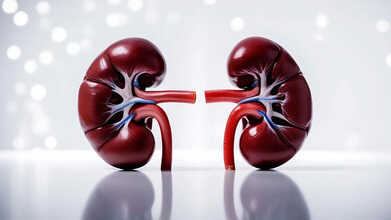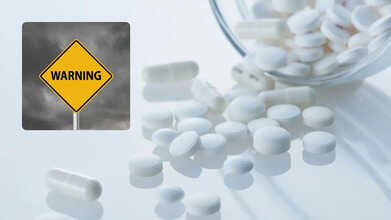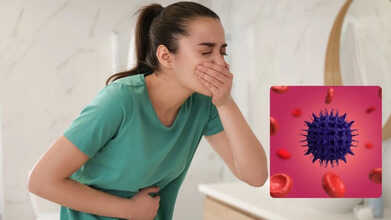- Health Conditions A-Z
- Health & Wellness
- Nutrition
- Fitness
- Health News
- Ayurveda
- Videos
- Medicine A-Z
- Parenting
- Web Stories
Hyderabad Faces Surge in Mysterious Kidney Disease Among Healthy Youth, Study Finds

Credits: Canva
A chronic kidney disorder of unknown origin, referred to as Chronic Kidney Disease of unknown etiology (CKDu), is leading to kidney failures in Hyderabad and nearby districts of Telangana, alarmingly affecting younger adults who are economically active and have no prior history of diabetes or high blood pressure.
A team of senior nephrologists from Osmania General Hospital (OGH) and Apollo Hospitals studied 75 patients and published their findings in the Indian Journal of Nephrology (August 2024). The study revealed that while the disease resembles the mysterious kidney failures reported in Andhra Pradesh and other states, it shows a distinct, city-specific pattern of risk in Hyderabad.
Mysterious Kidney Disease In Hyderadabad
A mysterious kidney condition, called chronic kidney disease of unknown etiology (CKDu), is increasingly being reported among younger, non-diabetic residents in Hyderabad and nearby districts of Telangana, a study led by nephrologists reveals. Unlike traditional CKDu cases, which are often associated with agricultural work and heat exposure, this urban group largely comprises small business owners and service-sector workers with no farming history.
“Our research confirms the presence of the CKDu phenotype in Telangana, beyond the established hotspot regions, showing that an agricultural background is not required for the disease to develop,” said Dr. Manisha Sahay, Head of Nephrology at OGH and lead author of the study.
While CKDu in other regions is typically linked to strenuous farm labor and heat exposure, clinical data from OGH indicate that different, non-occupational factors may be driving the disease in younger, economically active individuals with no farming history. The condition progresses silently, often only producing symptoms once the kidneys are severely damaged, making urgent treatment at hospitals like Osmania General Hospital necessary.
What Is Chronic Kidney Disease Of Unknown Etiology?
Chronic kidney disease of unknown etiology (CKDu) is a type of chronic kidney disease with no identifiable cause, commonly observed in agricultural communities in certain regions. It is believed to arise from multiple factors, including environmental exposures such as pesticides, heavy metals, heat stress, dehydration, and contaminated water. According to the International Society of Nephrology, CKDu is diagnosed when known risk factors for chronic kidney disease, such as diabetes and hypertension, are absent.
What Are The Possible Causes Of Chronic Kidney Disease Of Unknown Etiology?
While the exact cause of CKDu is not confirmed, researchers suggest several possible contributors. The disease is likely multifactorial, arising from a combination of factors rather than a single cause. Environmental toxins, including heavy metals, pesticides, and mycotoxins, are under investigation. Heat stress and repeated dehydration from strenuous work in hot climates may also damage kidney tubules. Other potential factors being studied include contaminated water supplies and viral infections.
Kidney biopsies of patients at OGH revealed widespread scarring and inflammation in the kidney’s filtering units, indicating that the disease starts silently in this critical compartment.
“The damage observed in these biopsies highlights the severe consequences of late diagnosis, a pattern seen consistently across all CKDu-affected regions. Since the disease remains largely asymptomatic in its early stages, patients often reach urban hospitals only when they urgently need dialysis or renal replacement therapy,” said Dr. Manisha Sahay, Head of Nephrology at OGH.
CKDu in Hyderabad Linked To Urban Lifestyles and Unregulated Herbal Remedies
“While globally, 60 to 80 percent of CKDu cases occur among agricultural workers, only 21.3 percent of the Hyderabad patients were involved in rice farming,” noted Dr. Manisha Sahay in the study. “This shows that the CKDu phenotype affects a broad range of individuals from non-agricultural backgrounds, including small business owners, service-sector employees, and urban residents.”
Adding to the concern, 40 percent of patients in the OGH study reported using unregulated alternative or herbal medicines. Researchers emphasize that this widespread local practice may represent a significant risk factor, highlighting the need for urgent public health investigations targeting local dispensaries and providers of traditional remedies.
NHS Issues ‘Burning Stomach’ Warning Over THIS Common Painkiller

Credits: Canva
Individuals using one of the UK’s most frequently prescribed painkillers should know about a rare side effect that can cause a severe burning sensation in the stomach. While this medication is widely used and taken regularly by many, health experts have now issued a warning regarding this potential reaction.
‘Burning Stomach’ Warning Over This Common Painkiller
Naproxen is a non-steroidal anti-inflammatory drug (NSAID), part of the same group as ibuprofen and aspirin. It helps reduce pain, inflammation, and swelling in muscles and joints. Doctors may prescribe it in tablet or liquid form for conditions like rheumatoid arthritis, osteoarthritis, gout, and menstrual cramps.
It’s also used to treat certain muscle or bone problems, including back pain, sprains, and strains. The duration of treatment can vary, some people only need a few days, while others may require longer-term prescriptions. If you take naproxen for an extended period, your doctor may also prescribe medication to reduce the risk of side effects.
According to the NHS, your naproxen dose depends on why you are taking it, your age, liver and kidney function, and how well it relieves your symptoms. Older adults and people with heart, liver, or kidney issues usually receive lower doses. For children, the dose is calculated based on weight.
Naproxen Side Effects
Like all medications, naproxen can cause side effects, though not everyone experiences them. Common issues, affecting about 1 in 100 people, include:
- Confusion
- Headache
- Ringing in the ears
- Vision changes
- Drowsiness or fatigue
- Dizziness
- Skin rashes
If any side effect persists or causes discomfort, speak with a doctor or pharmacist. In rare cases, naproxen can lead to severe stomach problems, such as intense indigestion, heartburn, or abdominal pain, which may indicate an ulcer or inflammation, according to the NHS.
Naproxen: NHS Issues Warning Over Naproxen
The NHS website claims: "Your doctor may tell you not to take naproxen if you have a stomach ulcer or you have had one in the past. If you need to take naproxen but are at risk of getting a stomach ulcer, your doctor may prescribe another medicine for you to take alongside naproxen to protect your stomach.”
The most common symptom of a stomach ulcer is a burning or gnawing pain in the centre of the stomach. But stomach ulcers are not always painful and some people may have other symptoms, such as indigestion, heartburn and feeling sick.
If you think you may have symptoms of a stomach ulcer, stop taking naproxen and contact your doctor. You can report any suspected side effect using the Yellow Card safety scheme.
New FDA Approved Medicine Offers Hormone-Free Relief From Menopause Sweats

Credits: Canva
The US Food and Drug Administration has given the green light to a new once-daily pill that works without hormones to ease moderate to severe hot flashes in menopausal women, Bayer announced Friday. The drug, called elinzanetant, will be available in the US starting in November under the brand name Lynkuet, according to Bayer.
It works by targeting brain chemicals responsible for hot flashes and night sweats, medically referred to as vasomotor symptoms. Experts estimate that over 80% of women experience hot flashes during menopause.
“This FDA approval marks a bold leap forward, our first non-hormonal treatment for vasomotor symptoms of menopause,” said Christine Roth, Bayer’s executive vice president of global product strategy and commercialization, in a news release Friday. “There’s a growing need for personalized approaches to menopause care, and Lynkuet fills a crucial gap in treatment options.”
For many women, hormone therapy can be a safe and effective way to manage symptoms like hot flashes. However, some women with certain health conditions or a history of diseases, including specific cancers, are sometimes advised against hormone replacement therapy. In such cases, alternative options like Lynkuet may be particularly valuable.
Clinical Trial Shows Promising Results
A Phase 3 clinical trial involving 628 postmenopausal women found that those taking elinzanetant for 12 weeks saw more than a 73% reduction in the frequency of their vasomotor symptoms, compared with a 47% reduction in those who received a placebo. The most commonly reported side effects were drowsiness, fatigue, and headaches.
“This year-long study not only confirmed rapid and substantial relief from the frequency and severity of hot flashes and night sweats but also showed that these benefits lasted for a full year, offering hope for long-term symptom control,” said Dr. JoAnn Pinkerton, director of midlife health at UVA Health and emeritus executive director of the North American Menopause Society, when the trial results were published.
“For women facing moderate to severe vasomotor symptoms during menopause, treatment options have been limited, especially for those who cannot or prefer not to use hormone therapy,” Pinkerton added. “Severe hot flashes can disrupt daily life, work, and home routines, highlighting the need for effective non-hormonal treatments.”
Hot Flashes and Night Sweats
Hot flashes are sudden, intense feelings of heat that usually affect the face, chest, and head. They can bring on heavy sweating and flushing for several minutes. Nighttime episodes are called night sweats. Women can experience hot flashes sporadically or multiple times a day, making them highly disruptive.
“It’s important that women know there are choices to treat moderate to severe hot flashes, and this approval gives healthcare providers another option,” said Claire Gill, president and founder of the National Menopause Foundation, in Bayer’s announcement.
A New Era of Menopause Treatment
In 2023, the FDA approved another non-hormonal menopause drug, fezolinetant, which also provides an alternative to traditional hormone therapies for hot flashes. Fezolinetant and elinzanetant are among the first drugs to target a recently discovered brain pathway involved in regulating hot flashes.
During menopause, declining estrogen levels trigger overactive nerves in the hypothalamus, a small region deep in the brain that helps control the body’s thermostat. These nerves release too many chemical signals called neurokinins. Both drugs block neurokinin receptors on brain cells, reducing the signals that trigger hot flashes.
“Severe hot flashes can significantly affect daily life,” Pinkerton said. “This approval gives healthcare providers a new, first-line option to help women with moderate to severe menopause-related hot flashes.”
Unique Symptoms of the ‘Unpleasant’ Winter Bug Spreading in UK, NHS Issues Alert

Credits: Canva
Health officials in the UK have issued a 48-hour warning after a rise in cases of an “unpleasant” winter bug. The UK Health Security Agency (UKHSA) has urged people to stay home for two days after symptoms subside to help stop the spread of norovirus, commonly known as the “winter vomiting bug.” The virus, which causes vomiting and diarrhoea, spreads easily, particularly in colder months.
Recent data shows that cases have started to climb across England in recent weeks. The NHS has supported the UKHSA’s advice, reminding people to remain at home for at least 48 hours after symptoms clear to avoid infecting others.
What Is The Winter Bug Spreading In UK?
Norovirus is a highly contagious group of viruses that cause sudden vomiting and diarrhea. It spreads easily through contaminated food, water, and surfaces, and is known to peak during the colder months. In fact, it’s the leading cause of foodborne illness in the United States.
The virus was first identified in 1968 after an outbreak in an elementary school in Norwalk, Ohio, which gave it its original name, the Norwalk virus.
Norovirus vs. the Stomach Flu
Although often called the “stomach flu,” norovirus is not related to influenza. The flu virus affects the respiratory system, while norovirus targets the digestive tract, causing gastroenteritis.
Types of Norovirus
Norovirus belongs to the Caliciviridae family and includes 10 groups with around 48 known types. Among these, the GII.4 strain is the one most often linked to widespread outbreaks.
Unique Symptoms of Norovirus
Here are some less-covered but important unique symptoms of Norovirus infection to watch for:
- A sudden, intense onset of vomiting and watery diarrhoea, often without warning.
- Rapid loss of appetite and stomach cramps that may begin only 12 to 48 hours after exposure.
- Feeling unwell with low-grade fever, head or body aches, chills or muscle pain that accompany the GI symptoms.
- Signs of dehydration early on, such as dark urine, dry mouth, faintness on standing, or crying with few or no tears especially in children, older adults or immune-weakened people.
Unusual how quickly it hits and how short-lived it often is: many people recover in 1-3 days, yet they can still spread the virus for days after symptoms stop
To help stop the virus from spreading, the NHS has urged people with symptoms to take extra care, as per NHS. Those affected should:
- Avoid going to work, school, or nursery until at least 48 hours after their last episode of vomiting or diarrhoea.
- Refrain from visiting hospitals, care homes, or other vulnerable settings during the same period.
- These precautions are crucial because norovirus remains highly contagious even after symptoms appear to have cleared.
How to Stop Norovirus from Spreading
Contaminated food and water can also transmit the virus. Along with staying home while you’re unwell, the NHS recommends taking the following precautions to reduce the risk of passing it on:
Wash your hands thoroughly with soap and warm water after using the toilet or changing nappies, alcohol-based hand gels do not kill norovirus.
- Clean your hands before handling food, whether you’re cooking, serving, or eating.
- Launder soiled clothes and bedding separately at 60°C if they’ve come into contact with vomit or stool.
- Disinfect frequently touched surfaces, including toilet seats, taps, flush handles, and door handles.
- Limit physical contact with others until you’ve been symptom-free for at least two days.
© 2024 Bennett, Coleman & Company Limited

